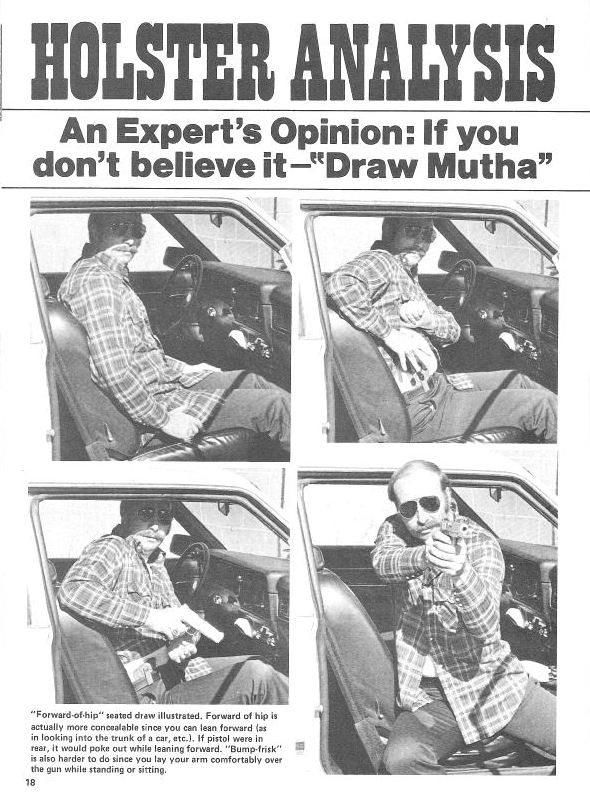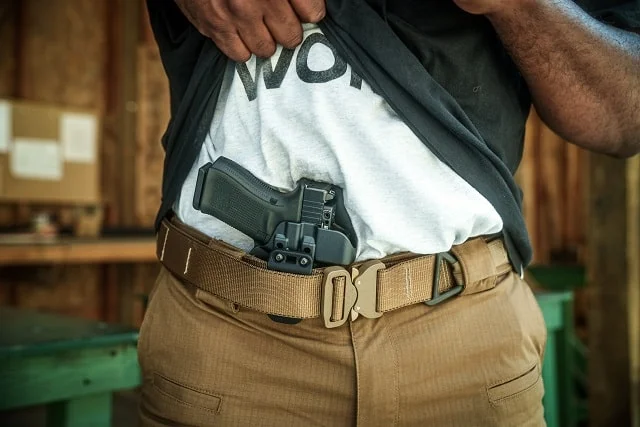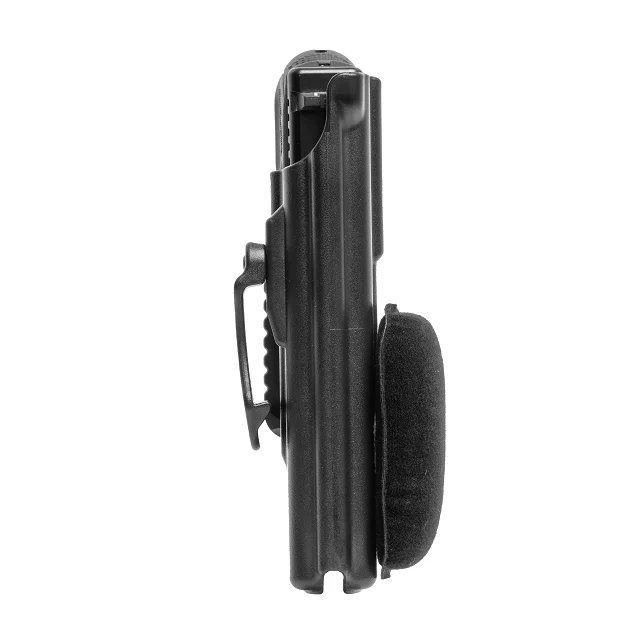
Appendix Carry Like A Pro With This Guide
Appendix carry has gotten more popular over the last decade or so. A lot more people have started to appendix carry rather than carry their gun behind the hip.
What is appendix carry? Appendix carry is where you place a pistol and holster in the front of the waistband. The typical placement is often about halfway between the pants pocket and the waistband button, close to the location of the appendix - hence the name.
The benefits of appendix carry are easy concealment, more convenient insertion into the waistband and an easier draw from concealment. However, there are some potential drawbacks that you should know about as well.
This guide will go over the basics of appendix carry, how it's done, what you need in order to appendix carry effectively, and how to counter the potential drawbacks of appendix carry.
What Is Appendix Carry?

Appendix carry is a contemporary term for an old practice, carrying a concealed pistol on the front of the body and usually on the side of the dominant hand.
In previous eras, a concealed pistol would either be carried in a pocket or in the front of the waistband, which is why compact pistols used to be called "belly guns" as that was where they were carried.
It wasn't just for civilians; a practice in law enforcement during the 19th and early 20th century was to tuck their Colt single action in the waistband with the loading gate open to keep it from sliding down into their pants, and concealed under their jacket or coat. In fact, police rarely wore their guns openly in most urban areas until the mid-20th century. Open carry was a lot less socially acceptable at the time, even for peace officers. Believe it or not, there were appendix carry holsters before there were cars.
The advantages were easier concealment than with a holster on the hip, and faster access than carrying a gun in your coat pocket.
Not that the practice ever died out, of course.
A lot of people think the classic Bruce Nelson Summer Special leather IWB holster design is for carrying a 1911 behind the hip…but Nelson actually designed it to work in the appendix position because that's how he carried his gun.

credit: GunNutsMedia.com
Nelson (also an early IPSC shooter and Gunsite instructor) was a police officer in California, and did a lot of undercover and plainclothes work in some very busy environments working narcotics. Appendix carry gave him a faster draw, easier access in vehicles, and was easier to conceal. He wasn't the only officer carrying this way, either.
What's old is new again, as the saying goes.
The term "appendix carry" itself came about some time in the 20th century (it's sometimes attributed to Jeff Cooper) and like other colloquialisms has caught on. But it all boils down to the same thing: keeping a concealed pistol on the front of the body, and for the reasons mentioned.
Why Appendix Carry?

The benefits of appendix carry are slightly better concealment compared to strongside carry, a faster draw from concealment, and easier access in a vehicle.
Effective concealment does take a little fine-tuning. The rear corner of the grip will imprint through the shirt if you haven't gotten your holster position and belt tension just right. You may need to add a muzzle wedge or a claw to optimize it, but the point is just because you've started to appendix carry doesn't mean instant foolproof concealment.
But what it does do is eliminate printing while bending over. A lot of people find more shirts work better with appendix carry compared to strongside carry, even with a full-size gun. That said, the gun will still be exposed if you lift your arms over your head, pulling your shirt above your belt...so once again, it doesn't mean instant and perfect deep concealment. It just means IWB concealment is a little easier.
As far as the draw to first shot goes, the secret to that is not mind-boggling. You don't have to move your hands as far to clear cover, draw the gun and present it to the target. More efficient motion means less time needed to perform it means faster.
Drawing from the appendix position also doesn't require the elbow to travel behind the body, which eliminates that tell-tale motion. That also makes a surreptitious draw - behind cover or people - far more possible.
Here's what the draw looks like from the appendix position…

…and here's what it looks like from behind the hip.

Look at how much further the dominant hand has to travel to get a grip on the gun to draw it.
Another advantage is that you don't need to create separation from yourself and a chair or car seat to draw the gun. Look at the picture earlier in this article of Bruce Nelson drawing the gun; he's doing it inside a car. The gun is forward of the hips, so a chair or carseat doesn't impede access.
Those are the benefits of appendix carry if you can make it work for you. But let's talk about what the challenges of appendix carry are and how to address them.
Is Appendix Carry Safe?

Thankfully, the criticisms of appendix carry as "unsafe" are beginning to die off, but enough people out there repeating these tropes so it bears discussion.
First is the trope about pointing a loaded gun at your genitals.
The first problem is that the best practice for appendix carry is usually to position the gun in the inguinal crease, where the leg meets the groin. So it shouldn't be pointed at the genitals to begin with.
Second, a gun that's properly holstered in a proper holster is for all intents and purposes inert. A trigger can't be pulled if its surrounded by hard molded polymer or what have you. If you practice safe gun handling, including carefully holstering your pistol, nothing will happen.
Besides, one of the first things you need to learn is to tilt your hips forward to holster your pistol. That way, you don't flag anything with the muzzle. And hopefully you don't need to be told to keep your finger off the trigger while holstering your gun!
Then we have urban legends about the femoral artery. Herein layeth some problems.

First, the femoral artery is tiny.
Normal size of the femoral artery, according to research published in Catheterization and Cardiovascular Interventions, Journal of Vascular Surgery, and the IOSR Journal of Dental and Medical Sciences, is somewhere between 7 millimeters to 16 millimeters, with an average of around 10 millimeters. That's an average of 1 centimeter, less than half an inch.
To hit the femoral artery with a bullet, a few things have to happen simultaneously. First, you have to have an accidental/negligent discharge. Second, the gun has to be oriented at the exact right angle so the bullet is on the exactly correct flight path to perforate it.
Not that it can't happen, but it requires a very specific set of circumstances to occur along with a failure of safe practices with firearms.
To date, there has only been one fatality attributed to a GSW to the femoral artery related to appendix carry. A young man had an accidental discharge while apparently trying to holster his pistol, striking him in the leg. His sister called for emergency services, but he unfortunately died on the operating table.
This is the case people talk about when they bring up the femoral artery trope…but here's what most people don't know.
At autopsy, it was discovered that he lost more blood from the thoracic cavity than the thigh. The bullet traveled down his leg and ricocheted up into his chest. So while he did hit his femoral artery, he actually died of a chest wound.
Further, it turns out - plot twist! - you're pointing the gun at your femoral artery when you carry on the hip too.
So…appendix carry is absolutely safe if you are safe. If you safely and competently handle a gun, and holster it in a proper appendix carry holster, it's just as safe as any other carry method.
How To Appendix Carry Comfortably

Another aspect to be aware of is comfort. Concealed carry has to be comfortable enough to be lived with, or you will find reasons not to do it.
So, how to make sure that it's comfortable.
First is positioning. The best position to start with is putting the holster (and gun) in the inguinal crease, where your leg meets your groin. There's a void of space there the holster can sit in, so it isn't poking or rubbing anything as you walk around or if you have to bend forward.
You may need to adjust the ride height of the holster if you can, which is why it's a good idea to get a holster that has adjustable ride height especially if you're first starting out with appendix carry.
Some people find the muzzle end of the holster rubbing or poking them. Add a wedge or pad to the muzzle end of the holster. That will create separation between the muzzle end of the holster and your groin.

If you find the holster is pressed tight up against you when you tension your belt, causing discomfort - or worse, interfering with your draw - you just need to add some material to the back.
Cut a strip off a yoga block, or cut a gel shoe insert to fit and add it to the back of the holster with a Command strip or hook and loop tape strips. It can make a big difference.
Can Fat Guys Appendix Carry? How To Use An AIWB With A Gut
Appendix carry for fat guys is just like anyone else. Add a wedge, add some foam to the back, and figure it out.
Most people who have (let's say) an abundant personality often find a bigger wedge and a bit more foam may be necessary. Easily done.
Another issue for bigger guys is carrying too small of a gun. The gut pushes the grip and the back of the slide outward. If you have more gun past the trigger guard, it resists against being pushed outward. With a holster wedge? Even more so! So you may need to carry a Glock 19 rather than a 26 or a 43.
A higher ride height for the holster can sometimes make a difference as well, in case the rear of the slide is below the apex of the belly. Get the gun a little higher, add some belt tension and you may be there.
It's rarely the case that anyone is absolutely unable to appendix carry if they have a few extra pounds. It just takes some optimizing to get right.
The Best Guns For Appendix Carry

There is no "best gun for appendix carry," there is a best gun for you to appendix carry.
One thing that's certain is that subcompact pistols are less ideal for appendix carry than compact or service-size pistols. Pistols with a shorter slide and barrel will tend to get pushed outward as there's not that much material past the trigger guard.
And that is exactly why extended-length subcompacts like the Glock 48, Sig P365XL, Hellcat Pro and Taurus G3XL have become a thing. The extra barrel length acts as a cantilever, keeping the belly from pushing the grip and back of the slide out too far.
However, some people will find that some guns are just too big. Longslide Glock models (G34, G35) Government 1911s and so on may be too much of a good thing!
Your mileage may vary. A lot of people have found a compact to full-size gun gets better results in terms of concealment, but plenty of people have no issues with a Ruger LCP II, a J-frame or an M&P Shield.
How To Choose An Appendix Carry Holster
So…you want to get an appendix carry holster. What do you need to look for?
The first order of business is that an appendix carry holster must fully enclose the trigger guard. The trigger guard has to be fully wrapped with either leather or hard polymer. Part of what a holster does is carry the gun in a safe condition, so no discharge is possible.
In the era of striker-fired pistols with no manual safety or way to control the firing mechanism (unless you get a Striker Control Device) this aspect is absolutely critical.
Your holster needs to be comfortable enough to deal with. You can augment that with a wedge and a bit of foam pad, but you should be able to live with it without them.
Some people, however, find they just can't deal with a full-wrap polymer holster. A hybrid design, with a shell that fully wraps the trigger guard, can be a serviceable alternative so long as the base doesn't collapse after the gun has been drawn.
If you find that to be the case, the ShapeShift Appendix Carry Holster is a perfect fit for you.

Others however, need a bit more in terms of features.
Some people find they need a wedge to push the muzzle out and a wing or claw to help push the top corner of the grip in. Some people need to be able to adjust the ride height, or may want to experiment with different belt attachments.
You might want to try a DCC Monobloc clip or pull-the-dot loops.
And some people want a simpler, more streamlined holster made of the most durable material they can get. If so, a full-wrap hard-sided holster with the capability to have attachments is definitely the better pick.
The Roswell IWB Holster is feature-rich at a super attainable price point. Adjustable cant and ride height, and it ships with a wedge and a claw if you need to use them. It can also be had in an optics-ready configuration, with an optic hood to protect your red dot sight.

You'll also want to pair your holster with a gun belt that's strong enough to give you the support you need to carry the gun, but with a little bit of give in it. A good leather gun belt works really well once it's broken in; a good tactical belt does too. We recommend Bigfoot Gun Belts.
But Is Appendix Carry Going To Work For Me?
There are some people for whom appendix carry isn't going to work. Some people have hip, shoulder or other physical issues that prevent them from successfully being able to appendix carry.
Your mileage, as they say, can vary.
And that's okay! If you find that you just can't make it work, then it may not be for you. But it's also that far more people than you'd think really have an issue that makes it untenable. Some people also find they just can't make a particular appendix carry holster work, but that they could make the practice work.
Give it a try if you feel up to it. And remember, all Alien Gear Holsters come with a 30-day Test Drive in case it doesn't...












